In part one of our series on better growth for CDMOs, we describe how contract development and manufacturing organizations (CDMOs) can create a better offering to their clients and extract the full benefit from the growth in this rapidly expanding segment.
As outlined in the series intro, the CDMO market has been growing rapidly in recent years and is expected to continue on this trajectory. However, to fully capitalize on this growth, CDMOs are faced with several commercial challenges that need to be overcome.
One of the biggest challenges that CDMOs face is the nature of their services, as they are complex and often bespoke.
It’s not easy to excel at offering such services because they require a high level of customization and tailoring to meet each client’s needs and requirements. This complexity makes it difficult to manage the offers even under normal circumstances, and even more so when trying to scale operations and meet the demand of this growing market.
If processes are set up inefficiently, this can potentially be balanced on a small scale, especially if only a limited number of highly experienced employees are responsible for managing the offer. However, scaling these operations and onboarding additional, but less experienced team members to support processes can quickly lead to issues – and the risks of losing deals due to slow proposal turnaround times, inaccurate pricing, over-/under-scoping, and not meeting client needs will increase exponentially. Essentially, it is key to find a proper balance between scoping projects from scratch, making them fully targeted and bespoke, and having predefined templates, archetypes, and standards around which to structure the ideal client offering.
The risk of a poor offering in times of growth is significant in itself. However, it is further underlined by the inorganic growth observed in the CDMO market, where integration of sites with their own legacy processes, and, ultimately, cross-site alignment of offering practices become critical to fully capitalize on the M&A investment and leverage the increased scale. This involves an aligned language for services and agreed levels of granularity. This is not only relevant to ensure consistency but also clarity, internally and externally, in order to avoid misalignment on scope or missed up-/cross-selling opportunities with clients.
These challenges can quickly add up, and unless tackled properly, CDMOs will find themselves missing growth targets or having to invest heavily to compensate the poor offering, sacrificing margins.
To avoid being left behind and to best participate in the growth of the CDMO market, let us show you how to successfully navigate the complexities around a better offering by employing a more systematic approach, improving quotation speed, reducing scope creep, and improving client fit.
From bottom-up, fully bespoke offer design to structured, pre-defined offer archetypes – the following blog tells you more about how to take advantage of the opportunities presented, position yourself for long-term success, ensure profitability, and ultimately be ready for better growth.
Why improving your current offering is relevant
With a better offer in place, leading to a more targeted treatment of client requests, CDMOs can benefit in terms of impact and speed.
By adjusting the offering to match your clients’ needs and willingness to pay, you can achieve better margins and maximize your revenue potential and profitability within the capacity at hand.
Furthermore, it helps you develop more effective internal processes by aligning your understanding of the services offered. Overall, you will be able to quickly and easily create customized solutions that meet the unique needs of each client, while improving efficiencies and reducing costs. As such, your proposal management teams will be empowered to generate initial scope and cost estimates without having to re-confirm each request with SMEs.
What does a better offer look like?
Creating better offer configurations enables you to efficiently and effectively define the best offer for each incoming request. But how exactly is a better offer defined? We have identified three key attributes:
Relevant: Being able to effectively and holistically address individual clients’ needs with a fitting solution that goes beyond standard CDMO services
Modular: Being able to easily and systematically add or remove offer items to extract willingness to pay and preserve margins via smart up-/down-selling
Consistent: Being able to re-create offerings at different levels of scale based on a defined set of standardized and internally and externally recognized service elements and respective offer archetyping
Put a better offer strategy in place today
You can’t call your offering relevant, modular, and consistent yet? If you’re looking to improve your offer and stay ahead of the competition, it’s essential to have a well-defined strategy in place.
The following five key steps help you create a better offer and unlock CDMO value:
1. Break down your offer into harmonized service elements
If you looked back at some quotes your company sent in the past, would you find the same services in all of them, or would they be customized for each client? Would they be described in the same way, with the same level of detail? Or would you get several different versions with inconsistent details?
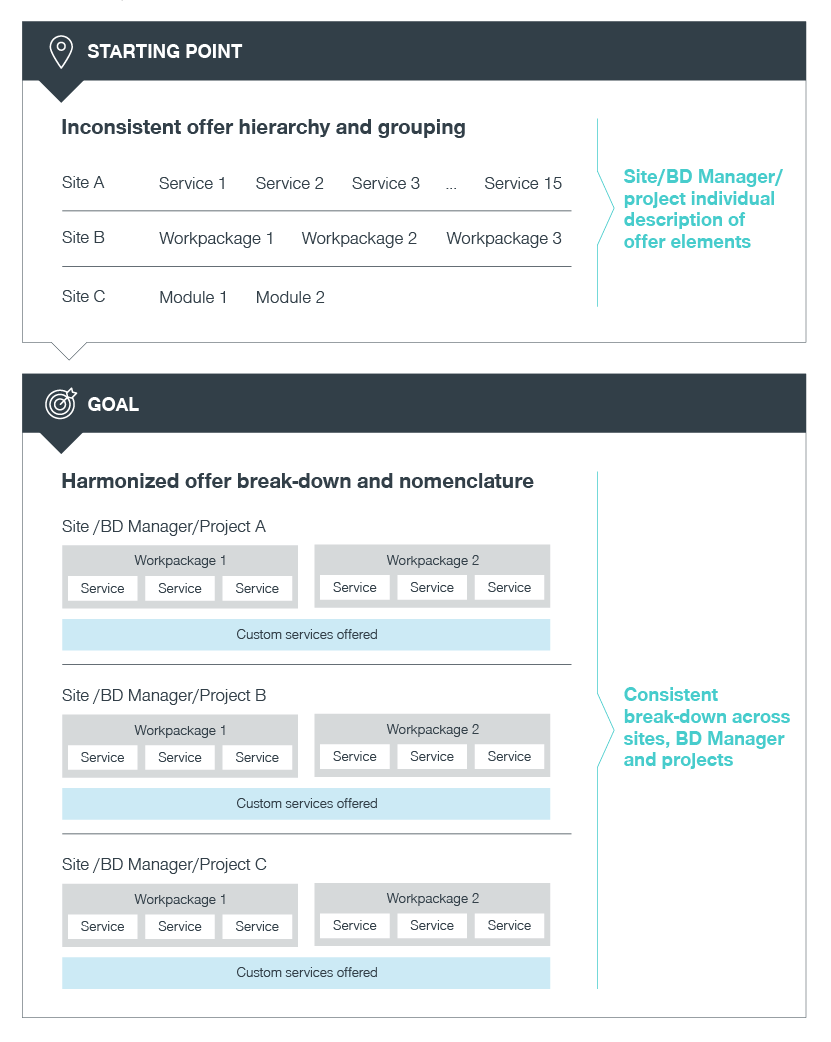
Best practice: Many CDMOs don’t have a clear offer hierarchy in place, even though the benefits are manifold. Therefore, the aim is to move from a high-level view of services to a view that reflects an in-depth understanding of each service offered. What that means for you: To get ultimate transparency on what you’re offering, develop a clear long list of all your services that everyone in the company can refer to.
A high level of detail can help your organization streamline internal communication, attach standard hours to standard services, understand when a service was customized for a specific request, and refine costing estimates. It also reduces alignment time between SMEs and proposal developers, ensuring that all departments speak the same language when communicating internally and with clients. Furthermore, it will help you better track labor and cost inputs, so you don’t get caught out by unexpected resource requirements.
2. Complement core offers with value-added services
Maybe you already have a long list of services – but in reality, the full service you offer to your clients goes beyond this list? Are there other service elements such as express delivery, data reports, or virtual person in plant that you frequently offer without explicitly mentioning them in your quotes? Do these services provide significant extra value to your clients that isn’t being monetized?
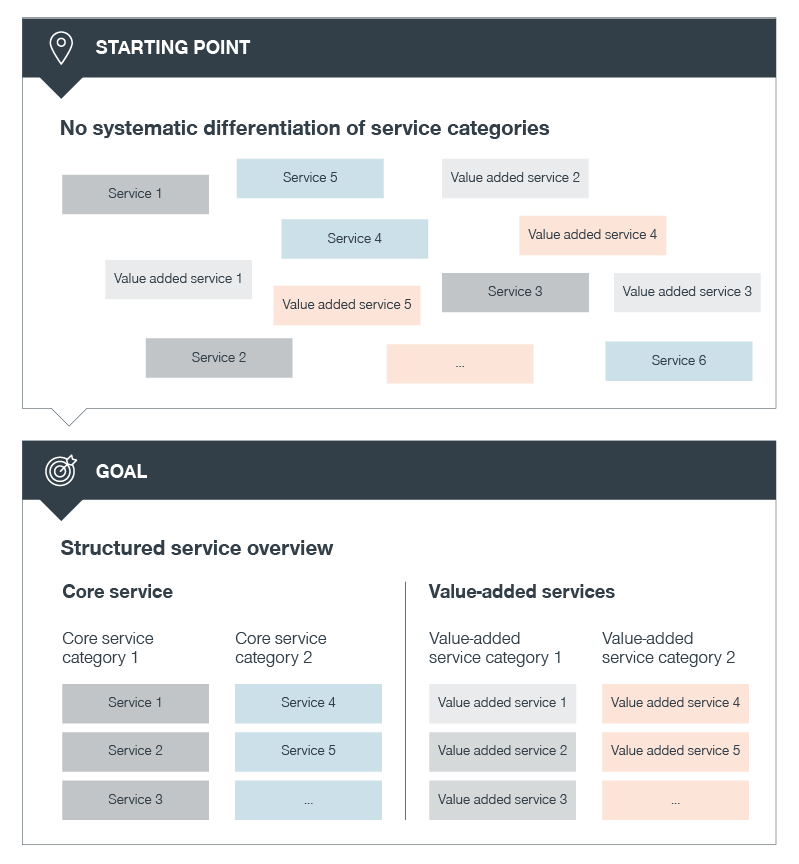
Best practice: Complement your service offering with value-added services. While core services are essential to successfully achieve project objectives, value-added services target the overall client experience during project execution and client needs that go beyond core project scopes. In our experience, value-added services are an excellent tool to not only capture client willingness to pay and create new revenue streams but also to differentiate from other CDMOs as a strategic partner with the client’s holistic needs top of mind.
What does that mean in practice? Let’s say that you identified data and monitoring as a value-added service category. Within this category, you should then outline the individual service items you offer, such as a real-time data dashboard and benchmarking via automated reports.
Clearly defining these value-added service offerings enables more aligned and effective communication both internally and externally with clients.
3. Describe the differential value of your offer elements
CDMO services can range from standard activities like reviewing documentation and procuring raw materials to highly differentiated development activities like formulation development. But clients don’t value all services equally. Is it clear internally which services drive the value of your offering? And do you understand how services are perceived in relation to one another and vs. the competition?
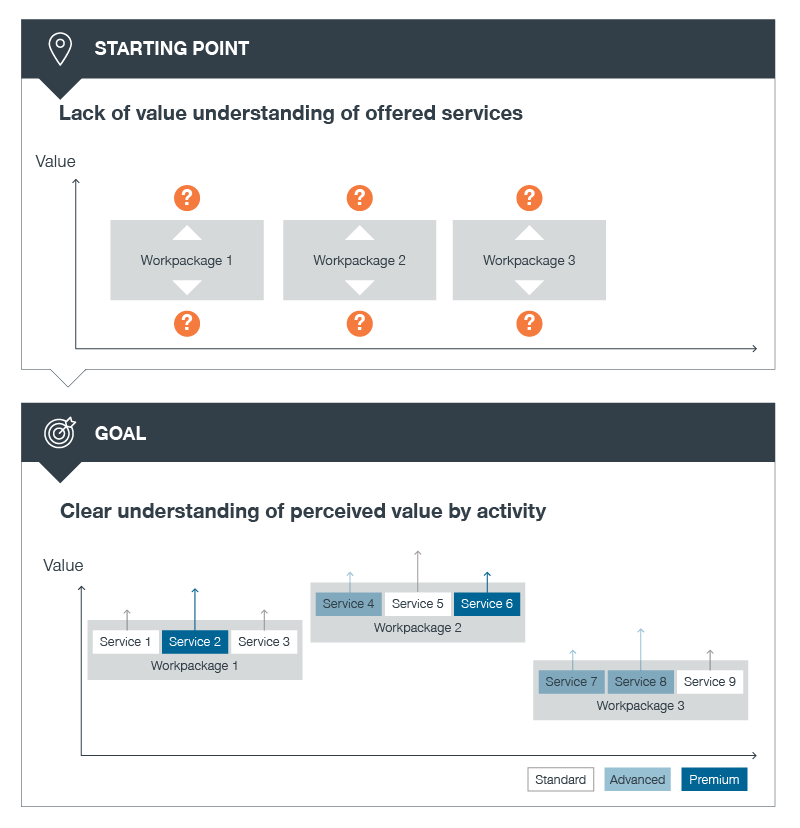
Best practice: In many CDMOs, there are different opinions on whether a service is basic and being offered by most other CDMOs, or whether it’s a unique proposition that stands out. This inconsistency can lead to different communication of the service’s value to clients, missed opportunities for value-based service pricing, and internal misalignment. To avoid such issues, it’s crucial to ensure that all services are classified accurately and consistently across your organization.
For you, this means identifying and clearly defining how clients perceive the value of your services and how you perform compared to the competition. Once you know the value of each service, you’ll be able to classify services by different value categories, e.g., standard, advanced, and premium. This transparency will help you differentiate offerings based on client needs. Moreover, it ensures you focus internal efforts on your most valuable activities, avoiding internal debates on priorities.
4. Define core service archetypes based on project requirements
A new client approaches you and requests an offer. Do you start from scratch, building the offer from the bottom up? Or do you have a one-size-fits-all offer that isn’t really tailored to anyone?
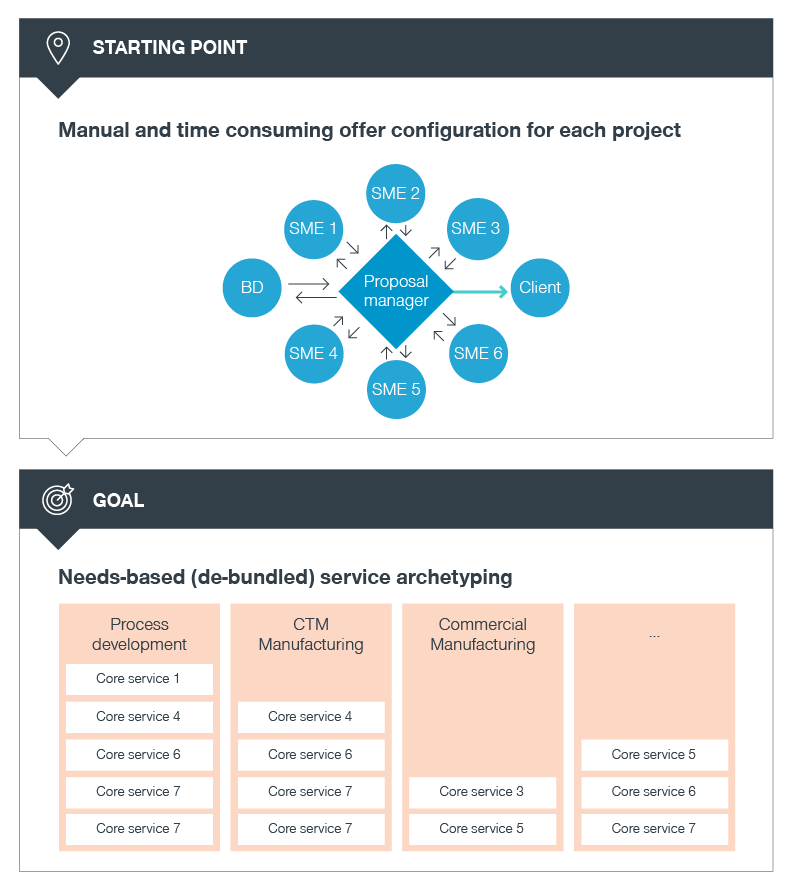
Best practice: Many CDMOs deploy proposal development teams to configure an initial offering based on the client’s RfQ and additional input derived from the business development team. Depending on the complexity of the request, this process can be cumbersome and time-consuming, as the proposal manager needs to get expert input from SMEs to finalize the offering.
Best-in-class CDMOs have service archetypes in place that are pre-configured with all the required service elements to successfully execute the project. Every incoming request is allocated to a service archetype to quickly derive a base configuration that can be used as a starting point for further offer refinement. Not only does this approach accelerate the quotation process by empowering the proposal manager to independently propose the initial scope, but it also helps institutionalize a consistent approach to project delivery within the organization. As a trusted advisor, the CDMO can recommend a typical offer configuration based on past experience with clients with similar requests, which can be especially valuable for smaller biotech clients that often have loose scope specifications in their RfQs and actively seek CDMO expert input during the quotation process.
What that means for you: Structure your portfolio by service archetypes to monetize value in line with client and project needs. Archetypes could be, for instance, early-phase development versus late phase offerings or in-house development versus tech transfer. This targeted starting point for scoping increases efficiency and consistency. On top, it establishes a common language that results in improved clarity in internal and external communication, enabling you to quickly turnaround offers based on similar project configurations and better address client and project needs.
5. Define value-added service archetypes based on client need profiles
How do you offer your value-added services? Is it in a knee-jerk response to a client request? Or are they simply given to clients without knowing and understanding their true value?
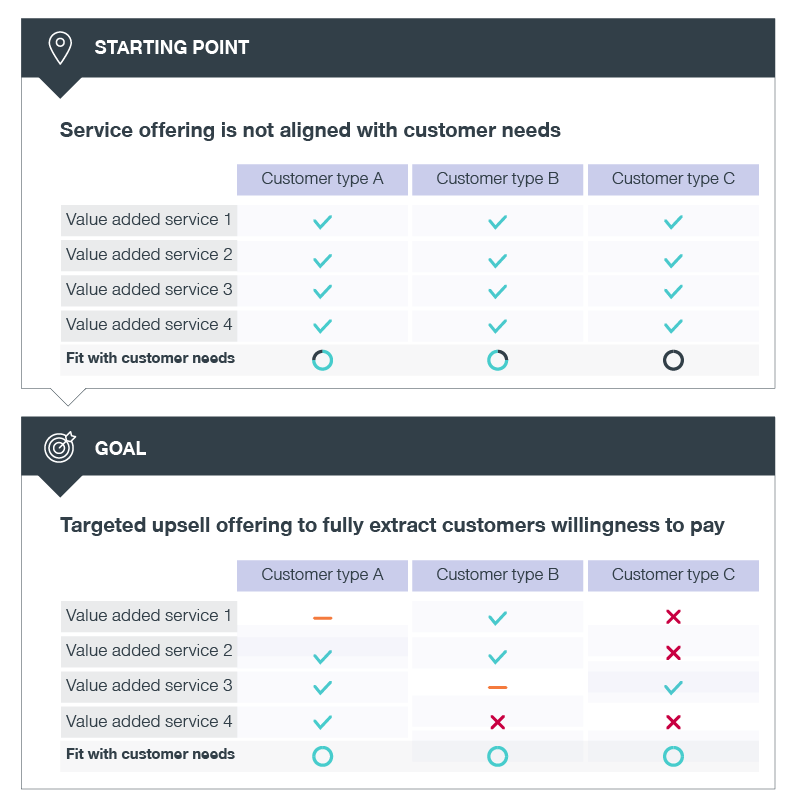
Best practice: Segment clients into differentiated need profiles and offer value-added services accordingly.
For example, a transaction-focused client that wants a leaner and low-cost offering should not be offered many value-added services. On the other hand, a knowledge-seeking client will likely value and pay for extras like automated reports and dashboards or VR technology (person in plant). This segmentation enables you to present a clear roadmap to clients and facilitates upselling, showing you the most efficient route to a high-end offer. It also provides down-selling pathways for clients with lower willingness to pay.
In fact, the value-added services can be used in a negotiation setting. Instead of agreeing to a price reduction on the core project scope, you can increase the likelihood of sealing the deal by offering selected value-added services at a 100-percent discount.
What’s next?
Through better offerings, we can help your CDMO unlock better growth. Not only benefiting from sales growth but also from improved value extraction thanks to more relevant, modular, and consistent offerings.
How you present your offer is only one part of the puzzle. Every offer must come with the right price – read part two here.
We believe CDMOs should benefit not only from the volume of service they deliver but also the value they generate. This requires a solid end-to-end process in terms of:
- Read part one: Better offering to unlock CDMO growth
- Read part two: Better pricing to unlock CDMO growth
- Read part three: Better quoting to unlock CDMO growth
Our series explores each of these topics, supported by best practices and extensive experience in helping CDMOs achieve better growth.
Want to see what this looks like for your company? Reach out to Kaan-Fabian Kekec and Omar Ahmad today!




